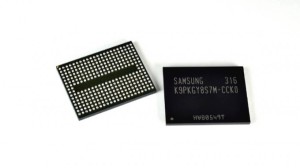 3D V-NAND, a new technology for packing more data into flash chips, will dramatically increase the number of PCs and enterprise storage systems that use flash in the next decade, a Samsung executive said Tuesday.
3D V-NAND, a new technology for packing more data into flash chips, will dramatically increase the number of PCs and enterprise storage systems that use flash in the next decade, a Samsung executive said Tuesday.
Over the next 10 years, the new technology will triple the percentage of client devices made with flash and double the percentage of enterprise storage systems that use it, said Jim Elliott, Samsung’s vice president of memory marketing.
The more dense media, made possible by stacking cells on top of each other instead of making them smaller and closer to each other, will increase the market for flash through lower cost per gigabyte for consumer gear and greater endurance for enterprise storage, Elliott said.
Elliott made his prediction at the Flash Memory Summit in Santa Clara, California, as Samsung announced its first SSD (solid-state disks) made with the new technology.
3D V-NAND overcomes problems such as interference that will keep conventional NAND from achieving greater density, said E.S. Jung, executive vice president of the company’s semiconductor R&D center. The latest NAND flash chips are manufactured with cells less than 20 nanometers across, and some experts believe it will be hard to take them below 10nm. 3D V-NAND opens the door to further increases in density, Samsung says.
As NAND cells storing bits get closer together, their signals are more likely to interfere with each other, like different kinds of music blasting from neighboring houses. Jung said. This interference introduces errors. Samsung overcame this and other problems by stacking 24 cells on top of each other while maintaining a comfortable distance between the stacks, Jung said. The company’s new 3D V-NAND SSD is made with a 30nm process.
The new SSD is now shipping to system makers in sample quantities. It comes in 960GB and 480GB versions. The 960GB product offers the biggest performance gains, boosting sequential and random write speeds by 20 percent and cutting power consumption by more than 40 percent, the company said. It did not disclose the price of the new media.





